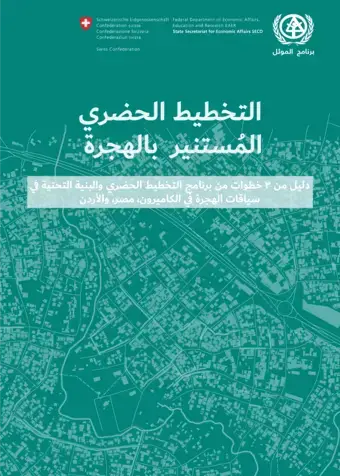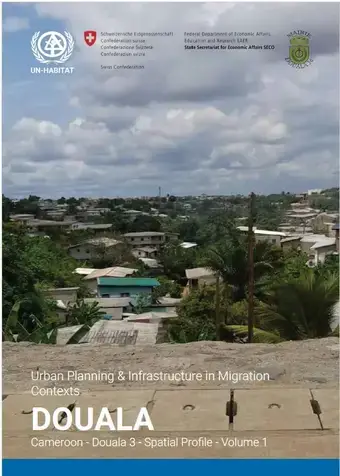Overview
The United Nations Human Settlements Programme "UN-HABITAT" has been collaborating with the Government of the Republic of Chad for 20 years. This collaboration has led to initiatives such as the Urban Development and Housing Improvement Project (DURAH) set up in 2004, which has made it possible to initiate a real policy dynamic to promote the sector; the creation of SOPROFIM in 2009 with the aim of improving urban housing and resolving the land question. In 2015, the "Banque de l'Habitat" was created and approved by COBAC in 2017.
The main areas of cooperation between Chad and UN-Habitat comprise urban development, legislation, social housing production, urban resilience and institutional capacity development.
UN-Habitat’s work in the country
UN-Habitat’s Country Programme in Chad is based on a solid partnership with all relevant public institutions and key stakeholders, including community-based organizations, NGOs and the private sector. Women and the youth are considered key players and are frequently consulted and responsible for the urban agenda in the country. Academia and educational institutions are also considered important partners.
Country: Overview
Country: Overview
Country: Overview
In Chad, only a small fraction of the urban population has access to decent housing and drinking water. A large majority are flood victims during the rainy season, and face day-to-day insalubrious conditions due to poor management of household human waste and wastewater, particularly in the outlying districts inhabited by the poor. Today, the aspirations of Chadians, expressed in the 2030 vision "The Chad We Want", demonstrates the willpower of Chad: "An emerging regional power by 2030, driven by diversified and sustainable sources of growth, creating added value and jobs, and ensuring that each Chadian has adequate access to basic social services, decent housing and adequate training opportunities".
Country: Impact and Urban Numbers
More than 365 sanitation committees have been formed and strengthened in 23 municipalities in Chad by the UN-Habitat Programme
More than 450 households in Chad benefit from the services of the BHT (Banque de l'Habitat du Tchad) and SOPROFIM (Société de promotion foncière et immobilière) created and implemented thanks to UN-Ha
More than 2500 students sensitized on the issues of climate change and sustainable urbanization
According to the United Nations Population Division, this population will increase to 27.5 per cent in 2030 and 39 per cent in 2050
Refugees and displaced persons from neighbouring countries fleeing armed conflict represent 302,675, or 84 per cent of the international migrant population in Chad.
Urban Population (2018): 23.1%
Urban Growth Rate (2015-2020): 3.88%
Country Beneficiaries
"Before the centre became a one-stop centre, we could have about 50 or more young people in the cells every day, arrested for various vagrancies. Today, we have at most 10 a week."
Fatimé Négué, Mayor of Sarh City
Donors and partners
Over the years, the UN-Habitat programme in Chad has forged a strong partnership with all forms of institutions and actors, ranging from public entities to grass-roots organizations, NGOs and the private sector. Young people and women are considered first-rate actors and are regularly empowered in activities concerning their spaces. Training institutes and universities are also daily partners.
Donors
Partners
Contact
Highlighted Publications
Legacy content
- Total value of UN-Habitat investments (2008-2013): US$ 2,126,966
- Total number of UN-Habitat projects (2008-2013): 1 project
- Main donors: UNDP Chad
- Implementing partners: Ministry of Housing, Urban Development and Regional Planning
Chad is divided into multiple regions: a desert zone in the north, an arid Sahelian belt in the centre and a more fertile Sudanese savanna zone in the south. Lake Chad, after which the country is named, is the largest wetland in Chad and the second-largest in Africa. N’Djamena (capital), Moundou, Sarh, Abeche, Kelo, Koumra are a few of its major cities.
General information
Capital: N’Djamena
Major cities: Chad is divided into multiple regions: a desert zone in the north, an arid Sahelian belt in the centre and a more fertile Sudanese savanna zone in the south. Lake Chad, after which the country is named, is the largest wetland in Chad and the second-largest in Africa. N’Djamena, Moundou, Sarh, Abeche, Kelo, Koumra are a few of its major cities.
- Population: 12.45 million
- GDP: US$12.89 billion
- GDP growth: 8.9%
- Urban population (annual %): 22%
- Population growth rate (average annual %): 3.0%
- Urban population growth rate (average annual %): 3.4%
- Rural population growth rate (average annual %): 2.9%
Source: World Bank 2012
UN-Habitat projects in Chad
Urban Development Improvement of Housing in Chad (Phase II)
In the period between 2008-2013, UN-Habitat carried out the phase II of a project aimed at improving the living conditions of urban poor including slum dwellers. The project was funded by UNDP Chad and implemented in conjunction with the Ministry of Housing, Urban development and Regional Planning.
Images





